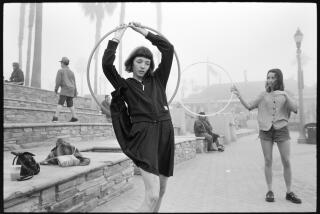Pictures of a Pioneer
- Share via
A new exhibition of vintage photographs of silent-film great Buster Keaton offers a unique glimpse into the life and career of the screen clown who starred in and directed such groundbreaking comedies as “The General,” “The Cameraman” and “Sherlock Jr.”
“Buster Keaton Revisited: Rare Photographs of a Comic Genius,” opening Friday at the Academy of Motion Picture Arts and Sciences’ Grand Lobby Gallery in Beverly Hills, features 72 Keaton pictures, many created from original negatives. Among them are film stills, family photographs--including an extremely rare baby picture, publicity shots, off-screen moments and images from his final years with his wife, Eleanor. Other highlights: a whimsical portrait from 1930 of Keaton staring at a toy version of himself and a behind-the-scene glimpse of Keaton in action from “The Cameraman.”
The pictures come from the collections of Keaton stills at the academy’s Margaret Herrick Library. These photos also serve as the basis for the new coffee-table book, “Buster Keaton Remembered,” by the late Eleanor Keaton and Jeffrey Vance.
Academy curator Robert Cushman says that the exhibition offers a real sense of not only how Keaton worked and conducted himself on a set, but also “a real sense of his character--of the character he projected.”
Three years ago, Eleanor Keaton donated her collection of photographs to the library. “The reason she gave it to us is that we have so much Keaton material here,” says Cushman, noting that her collection is “a great complement to what we already have . . . we had very little of the period when he met Eleanor and until the end of his life. And 98% of her collection were photographs from the last 25 years of his life.”
The two biggest sources for Keaton stills come from the MGM and Jules White collections. The MGM collection contains huge files on Keaton’s seven MGM talkies, as well as five of his silent films. On average there are two to 300 photos per file. “We have original negatives on many of them from which many of the exhibit prints were made,” Cushman says.
“White was the head of the Columbia shorts department,” says Cushman. “His collection came in ’75. He donated it himself.
More than 1,000 stills from Keaton’s silent days may have come from the Great Stone Face himself. “When I started here in ‘72, [the library] was in the Melrose Avenue Theater,” Cushman says. “They had a lot of library things stored in the basement area. Part of my job was to go through stuff and figure out what was there.”
Cushman was intrigued with an unmarked dusty box. “I opened it and there were all of these photos rolled up into scrolls. There might be like 100 curled up in circular scrolls.” The box contained more than 1,200 Keaton stills from nine of his silent features, as well as from 10 of his shorts from the years 1920-22.
Luckily, because these rare photographs had not been damaged by moisture, they weren’t stuck together. “Basically we peeled them off very carefully, submerged them in water, rewashed them and dried them. The result is a beautifully reglossed print.”
Cushman says he’s virtually certain the box came from Keaton. “They have all of the earmarks of having come from him,” he says. “There are some set references and locations references that no one else but he would have had. But there is no paperwork. So it’s an assumption, but it is a pretty good assumption.
“Few people today have an opportunity to pursue any chance to see old photography,” he added. “Very few people know how great it was.”
Cushman notes how crisp the images are. “They used the 8-by-10-inch negative format,” he explains. “There was such great detail that you don’t get today in formats used. An 8-by-10 negative is 80 square inches and a 35 millimeter negative [used today] is not even 2 square inches. So you have an enormous negative and it’s a very fine grain film, so therefore you get amazing detail where you can practically count the hair in their eyelashes.”
Most of the photographers who caught these indelible snapshots of Keaton are unknown. “In terms of the silent era, 99% of them we don’t know,” says Cushman. “Very few people realize this, but by the ‘20s the average major feature film would issue and use as many as 300 stills. Of course, many more were shot. They took [still] photography very seriously, and in many cases, the cinematographer would double as a still photographer.”
About 10 Keaton stills in the exhibit are not included in the book. “We kept finding things and I have been acquiring quite a bit lately,” says Cushman. “We found some really special things after the book had gone into production.”
*
* “Buster Keaton Revisited: Rare Photographs of a Comic Genius,” at the Grand Lobby Gallery, the Academy of Motion Picture Arts and Sciences, 8949 Wilshire Blvd., Beverly Hills, Friday-July 8. Hours: 10 a.m.-5 p.m. Tuesday-Friday and noon to 6 p.m. weekends. Admission is free. For information, call (310) 247-3600.
More to Read
The biggest entertainment stories
Get our big stories about Hollywood, film, television, music, arts, culture and more right in your inbox as soon as they publish.
You may occasionally receive promotional content from the Los Angeles Times.











